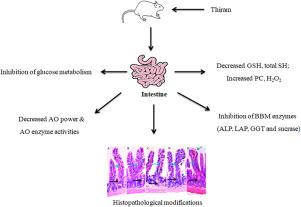Pesticide Biochemistry and Physiology ( IF 4.2 ) Pub Date : 2021-07-15 , DOI: 10.1016/j.pestbp.2021.104915 Samreen Salam 1 , Zarmin Iqbal 1 , Aijaz Ahmed Khan 2 , Riaz Mahmood 1

|
Pesticides are extensively employed worldwide, especially in agriculture to control weeds, insect infestation and diseases. Besides their targets, pesticides can also affect the health of non-target organisms, including humans The present study was conducted to study the effect of oral exposure of thiram, a dithiocarbamate fungicide, on the intestine of rats. Male rats were administered thiram at doses of 100, 250, 500 and 750 mg/kg body weight for 4 days. This treatment reduced cellular glutathione, total sulfhydryl groups but enhanced protein carbonyl content and hydrogen peroxide levels. In addition, the activities of all major antioxidant enzymes (catalase, thioredoxin reductase, glutathione peroxidase and glutathione-S-transferase) except superoxide dismutase were decreased. The antioxidant power of the intestine was impaired lowering the metal-reducing and free radical quenching ability. Administration of thiram also led to inhibition of intestinal brush border membrane enzymes, alkaline phosphatase, γ-glutamyl transferase, leucine aminopeptidase and sucrase. Activities of enzymes of pentose phosphate pathway, citric acid cycle, glycolysis and gluconeogenesis were also inhibited. Histopathology showed extensive damage in the intestine of thiram-treated rats at higher doses. All the observed effects were in a thiram dose-dependent manner. The results of this study show that thiram causes significant oxidative damage in the rat intestine which is associated with the marked impairment in the antioxidant defense system.
中文翻译:

口服福美双抑制刷状缘膜酶,氧化蛋白质和硫醇,损害氧化还原系统并导致大鼠肠道组织学变化:剂量依赖性研究
农药在世界范围内广泛使用,特别是在农业中用于控制杂草、虫害和疾病。除了它们的目标外,杀虫剂还会影响非目标生物的健康,包括人类。本研究旨在研究福美双(一种二硫代氨基甲酸酯类杀菌剂)的口服暴露对大鼠肠道的影响。雄性大鼠以 100、250、500 和 750 毫克/公斤体重的剂量服用福美双,持续 4 天。这种处理减少了细胞谷胱甘肽、总巯基,但增加了蛋白质羰基含量和过氧化氢水平。此外,除超氧化物歧化酶外,所有主要抗氧化酶(过氧化氢酶、硫氧还蛋白还原酶、谷胱甘肽过氧化物酶和谷胱甘肽-S-转移酶)的活性均降低。肠道的抗氧化能力受损,降低金属还原和自由基淬灭能力。福美双的给药还导致肠道刷状缘膜酶、碱性磷酸酶、γ-谷氨酰转移酶、亮氨酸氨肽酶和蔗糖酶的抑制。磷酸戊糖途径、柠檬酸循环、糖酵解和糖异生酶的活性也受到抑制。组织病理学显示,在较高剂量下,福美双治疗的大鼠肠道出现广泛损伤。所有观察到的效果都是福美双剂量依赖性的。这项研究的结果表明,福美双会在大鼠肠道中造成显着的氧化损伤,这与抗氧化防御系统的显着损伤有关。福美双的给药还导致肠道刷状缘膜酶、碱性磷酸酶、γ-谷氨酰转移酶、亮氨酸氨肽酶和蔗糖酶的抑制。磷酸戊糖途径、柠檬酸循环、糖酵解和糖异生酶的活性也受到抑制。组织病理学显示,在较高剂量下,福美双治疗的大鼠肠道出现广泛损伤。所有观察到的效果都是福美双剂量依赖性的。这项研究的结果表明,福美双会在大鼠肠道中造成显着的氧化损伤,这与抗氧化防御系统的显着损伤有关。福美双的给药还导致肠道刷状缘膜酶、碱性磷酸酶、γ-谷氨酰转移酶、亮氨酸氨肽酶和蔗糖酶的抑制。磷酸戊糖途径、柠檬酸循环、糖酵解和糖异生酶的活性也受到抑制。组织病理学显示,在较高剂量下,福美双治疗的大鼠肠道出现广泛损伤。所有观察到的效果都是福美双剂量依赖性的。这项研究的结果表明,福美双会在大鼠肠道中造成显着的氧化损伤,这与抗氧化防御系统的显着损伤有关。糖酵解和糖异生也受到抑制。组织病理学显示,在较高剂量下,福美双治疗的大鼠肠道出现广泛损伤。所有观察到的效果都是福美双剂量依赖性的。这项研究的结果表明,福美双会在大鼠肠道中造成显着的氧化损伤,这与抗氧化防御系统的显着损伤有关。糖酵解和糖异生也受到抑制。组织病理学显示,在较高剂量下,福美双治疗的大鼠肠道出现广泛损伤。所有观察到的效果都是福美双剂量依赖性的。这项研究的结果表明,福美双会在大鼠肠道中造成显着的氧化损伤,这与抗氧化防御系统的显着损伤有关。











































 京公网安备 11010802027423号
京公网安备 11010802027423号